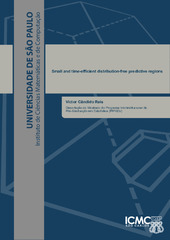| dc.contributor.author | Reis, Victor Candido | |
| dc.date.accessioned | 2023-05-26T18:24:49Z | |
| dc.date.available | 2023-05-26T18:24:49Z | |
| dc.date.issued | 2023-05-02 | |
| dc.identifier.citation | REIS, Victor Candido. Small and time-efficient distribution-free predictive regions. 2023. Dissertação (Mestrado em Estatística) – Universidade Federal de São Carlos, São Carlos, 2023. Disponível em: https://repositorio.ufscar.br/handle/ufscar/18077. | * |
| dc.identifier.uri | https://repositorio.ufscar.br/handle/ufscar/18077 | |
| dc.description.abstract | Predicting a target variable (response) is often the main objective of many studies and investigations. In such scenarios, there are usually other variables, known as covariates, that are more readily available and can assist in the prediction process. Regression and classification methods aim to utilize the statistical associations between all available information to model the variable of interest. During such modeling, there is a significant emphasis on estimating regions that describe the fluctuations of the response, allowing for the quantification of the uncertainty of point estimates.
Conformal prediction methods (VOVK; GAMMERMAN; SHAFER, 2005) are a class of methods that aim to provide regions with general shapes and high probability guarantees, assuming only exchangeability, which is a weaker assumption than independent and identically distributed data. This allows for extensive use in various applications. New methodologies have been developed to improve the theoretical properties and applicability of the original ideas, with a practical perspective on execution and computational cost.
Motivated by this context, this work aims to enrich the class of conformal prediction methods, with a particular focus on regression problems and proposes a new method that better utilizes available information, provides greater generality in the format of the regions, and is more efficient in terms of computational cost.
The proposed method was compared with previous works using simulation studies, and it achieved competitive results. | eng |
| dc.description.sponsorship | Coordenação de Aperfeiçoamento de Pessoal de Nível Superior (CAPES) | por |
| dc.language.iso | eng | por |
| dc.publisher | Universidade Federal de São Carlos | por |
| dc.rights | Attribution-NonCommercial-NoDerivs 3.0 Brazil | * |
| dc.rights.uri | http://creativecommons.org/licenses/by-nc-nd/3.0/br/ | * |
| dc.subject | Conformal prediction | eng |
| dc.title | Small and time-efficient distribution-free predictive regions | eng |
| dc.title.alternative | Regiões preditivas flexíveis, eficientes e livres-de-suposição | por |
| dc.type | Dissertação | por |
| dc.contributor.advisor1 | Izbicki, Rafael | |
| dc.contributor.advisor1Lattes | http://lattes.cnpq.br/9991192137633896 | por |
| dc.description.resumo | Frequentemente, prever uma variável alvo (resposta) é objeto
de interesse de investigações e estudos.
Nesse cenário, é comum existirem variáveis mais acessíveis (covariáveis) que podem ajudar no processo de previsão.
Métodos de regressão e classificação
surgem então com o objetivo de usar as associações estatísticas entre
todas as informações disponíveis para modelar a variável de interesse.
Há um grande foco, durante tal modelagem, em estimar regiões que
descrevam a flutuação da resposta, possibilitando, por exemplo,
quantificar a incerteza de estimativas pontuais.
Conformal prediction é uma classe de métodos derivada de Vovk, Gammerman and Shafer (2005) que busca fornecer
regiões com formas gerais e garantia de alta probabilidade, assumindo, basicamente, apenas permutabilidade das observações, suposição mais fraca do que dados independentes e identicamente distribuídos, o que permite
seu uso extensivo. Novas metodologias têm sido desenvolvidas para aprimorar as propriedades teóricas dessa classe, bem como a aplicabilidade das ideias originais do ponto de vista prático de execução e custo computacional.
Este trabalho objetivou enriquecer a classe de Conformal prediction com foco em problemas de regressão,
propondo uma nova abordagem que reúne um
melhor aproveitamento dos dados com uma maior generalidade
no formato das regiões, em uma perspectiva de custo computacional mais eficiente.
Resultados competitivos foram encontrados ao comparar o método proposto com trabalhos anteriores via estudos de simulação. | por |
| dc.publisher.initials | UFSCar | por |
| dc.publisher.program | Programa Interinstitucional de Pós-Graduação em Estatística - PIPGEs | por |
| dc.subject.cnpq | CIENCIAS EXATAS E DA TERRA::PROBABILIDADE E ESTATISTICA::ESTATISTICA::INFERENCIA NAO-PARAMETRICA | por |
| dc.description.sponsorshipId | 88887.634340/2021-00 | por |
| dc.publisher.address | Câmpus São Carlos | por |
| dc.contributor.authorlattes | http://lattes.cnpq.br/2436861079295576 | por |

